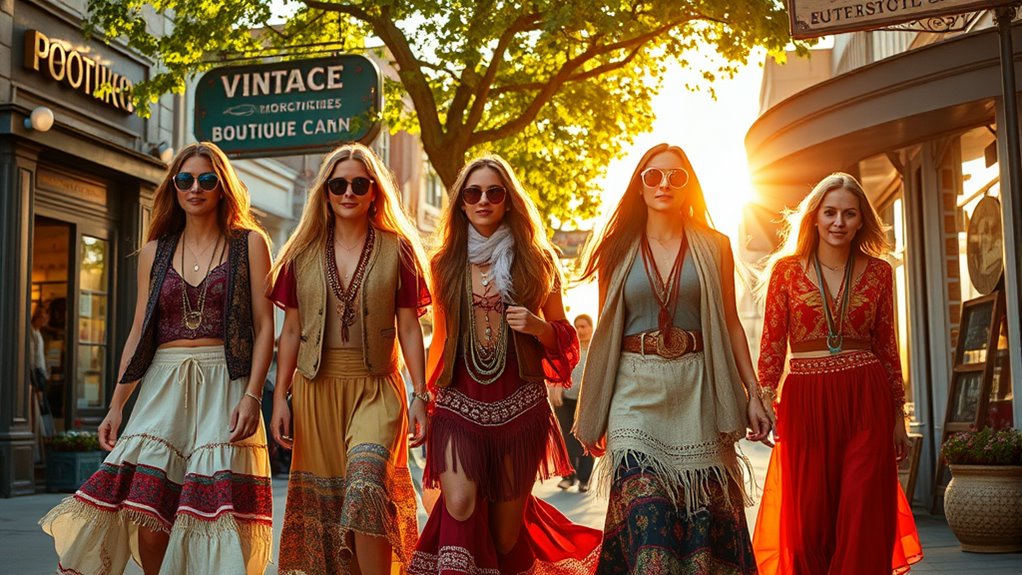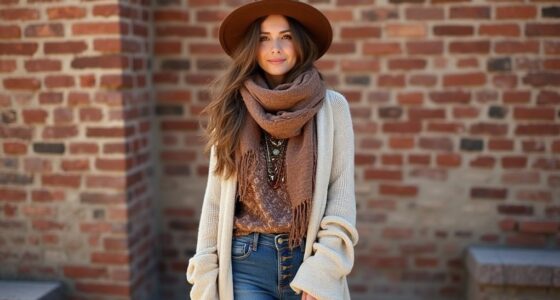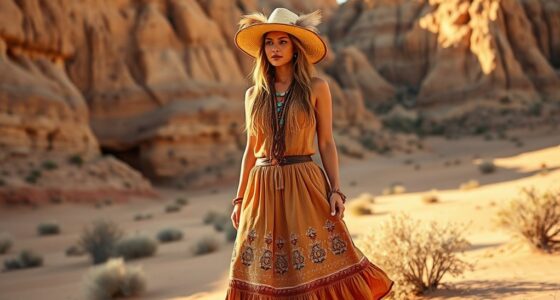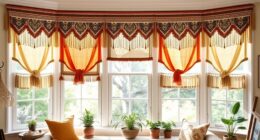From its roots in ancient Bohemia, where craft traditions and cultural influences thrived, bohemian fashion evolved through artistic movements like Romanticism and Arts and Crafts. It shifted from a rebellious subculture into mainstream style by embracing vintage, tribal, and ethnic patterns, emphasizing craftsmanship and sustainability. Today, boho-chic combines eco-friendly fabrics with modern minimalism, reflecting individuality and freedom. To discover how this eclectic style transformed over time and remains popular, explore the full story behind bohemian fashion’s enduring legacy.
Key Takeaways
- Bohemian fashion originated in Bohemia’s diverse cultural and artisanal traditions, emphasizing handcrafted textiles and spiritual symbolism.
- 19th-20th-century globalization and artistic movements like Romanticism popularized boho styles beyond regional roots.
- The style transitioned from underground subcultures to mainstream fashion through celebrity influence and retail integration.
- Contemporary boho-chic incorporates sustainable fabrics, vintage patterns, and cultural craftsmanship, blending tradition with modern minimalism.
- Advances in textile technology and digital platforms have expanded boho fashion’s global reach and ongoing evolution.
The Origins of Bohemia and Its Cultural Significance
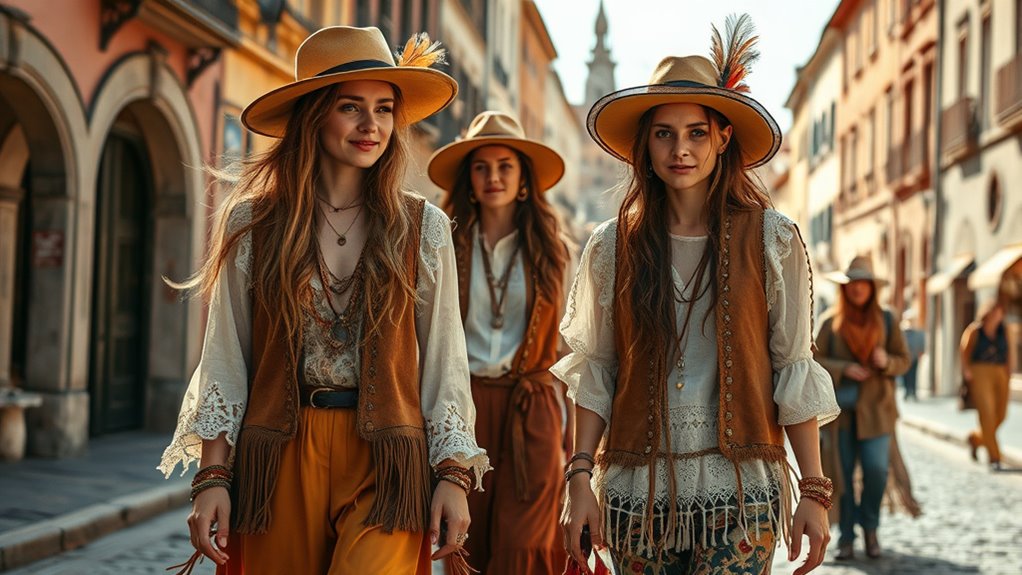
The origins of Bohemia date back to ancient times when it was a region inhabited by Celtic tribes before becoming part of the Holy Roman Empire. Its geographic history shaped a diverse cultural landscape, influenced by its central European location. You’ll find that traditional crafts and textiles play a key role in Bohemia’s heritage, reflecting centuries of skilled craftsmanship. Local artisans developed unique weaving techniques and vibrant patterns that have been passed down through generations. These textiles often feature intricate embroidery and natural dyes, showcasing the region’s rich artisanal tradition. Bohemia’s craftwork not only served practical purposes but also became a symbol of regional identity and cultural pride. The deep-rooted history of traditional crafts laid the foundation for the distinctive artistic expressions that define Bohemian culture today, highlighting the importance of cultural heritage preservation in maintaining these artistic traditions. Moreover, many of these craft techniques are now recognized as part of the region’s intangible cultural heritage, emphasizing their significance for future generations. Additionally, ongoing efforts to document and safeguard these crafts help ensure their survival amid modern influences.
Artistic Movements and the Rise of Bohemian Identity
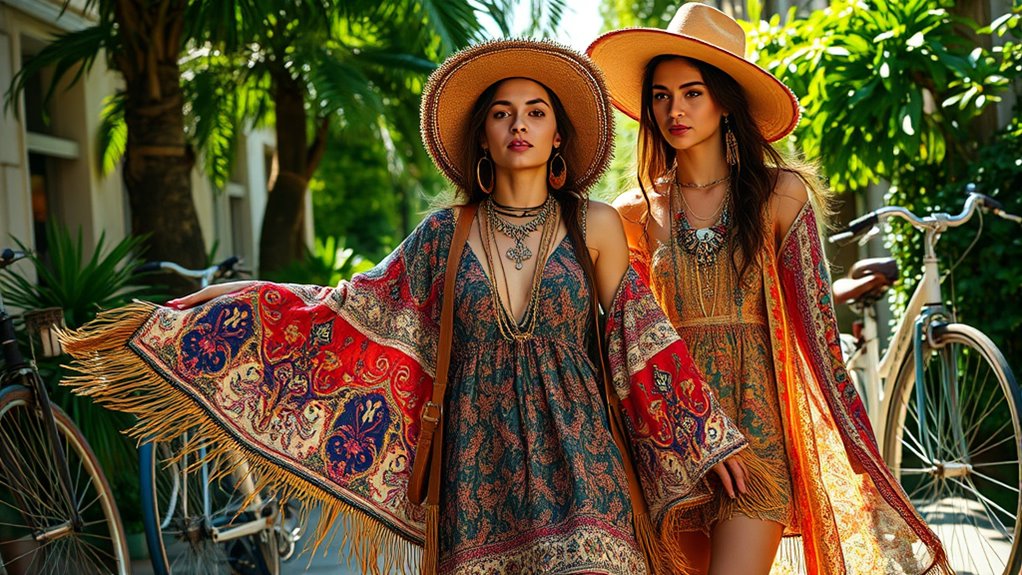
You can see how artistic movements like Romanticism and Impressionism shaped the free-spirited style of Bohemia. Cultural exchanges with diverse regions brought new ideas and aesthetics that fueled this identity. These influences come together to define the unique, creative spirit behind Bohemian fashion. Additionally, the incorporation of historical cultural significance from various eras and societies further enriched the eclectic and expressive character of Bohemian style. The understanding of cost variance and other financial concepts highlights how diverse influences can also be seen in the evolution of fashion trends over time. Moreover, developing Cultural Intelligence can enhance appreciation for the diverse origins and meanings embedded in Bohemian fashion.
Artistic Roots and Inspirations
As artistic movements like Romanticism and Symbolism gained momentum in the 19th century, they profoundly influenced the Bohemian identity by emphasizing individual expression, unconventional lifestyles, and a rejection of mainstream norms. You’ll notice how Bohemians drew inspiration from medieval craftsmanship, valuing handmade textiles, intricate embroidery, and artisanal details that reflected a return to craftsmanship’s authenticity. Religious symbolism also played a role, inspiring motifs like crosses, angels, and celestial imagery, which symbolized spiritual freedom and personal belief. These elements helped shape a style that celebrated creativity, mysticism, and a rejection of industrial mass production. Additionally, the regional influences of different cultures contributed to the eclectic and diverse nature of Bohemian fashion, further emphasizing its rejection of uniformity. The incorporation of textured fabrics and layered textiles also contributed to the rich, artisanal aesthetic that characterizes Bohemian style. By embracing these artistic roots, Bohemian fashion became a visual language of rebellion, spiritual exploration, and appreciation for handcrafted beauty, which reflects a deep respect for tradition and individual craftsmanship.
Cultural Exchange Influences
Cultural exchanges during the 19th and early 20th centuries profoundly shaped the Bohemian identity by blending diverse artistic movements and traditions. As globalization trends accelerated, you notice how ideas, styles, and craftsmanship from different regions merged, fostering a unique eclecticism. This cross-pollination inspired bohemians to embrace freedom and individuality, reflected in their clothing and lifestyle. The table below highlights key influences:
| Artistic Movement | Region of Origin | Impact on Bohemian Style |
|---|---|---|
| Romanticism | Europe | Emphasized emotion, flowing fabrics |
| Arts and Crafts | England | Handcrafted textiles, natural motifs |
| Symbolism | France | Mystical symbols and layered accessories |
| Japonism | Japan | Asian-inspired prints and patterns |
| Modernism | Global | Minimalist silhouettes and innovative materials |
This cultural exchange fueled the evolution of boho-chic, embracing global trends and diverse artistic expressions. Additionally, the movement’s openness to various cultural elements fostered a truly global aesthetic that continues to inspire designers today. Moreover, this blending of influences exemplifies how artistic movements can shape fashion trends across eras.
Key Influences: Vintage, Tribal, and Ethnic Patterns
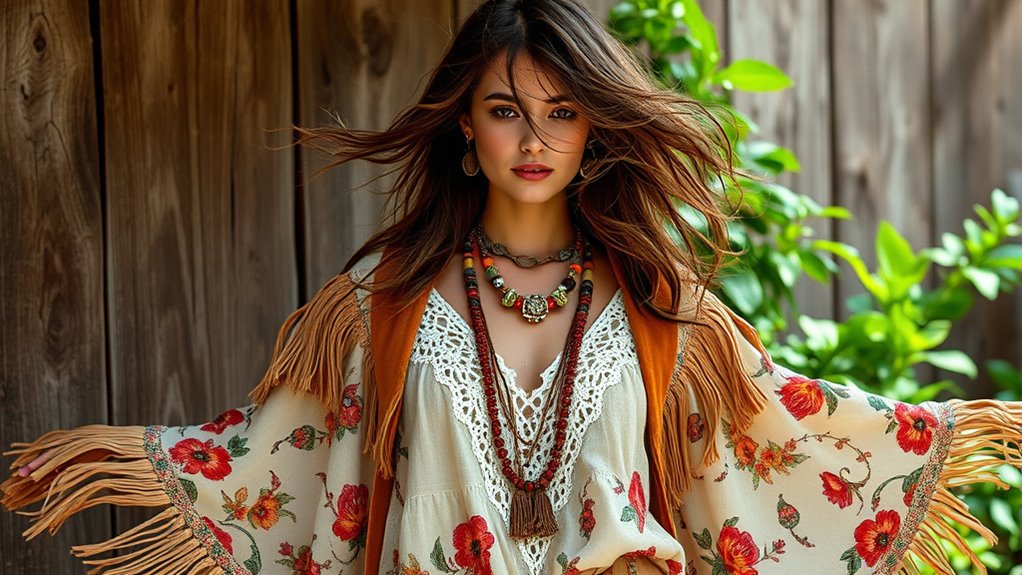
Vintage, tribal, and ethnic patterns have played an essential role in shaping bohemian fashion, adding a rich tapestry of colors, textures, and symbolism. These patterns often draw from diverse cultures and eras, giving your style a sense of history and authenticity. They also promote sustainable fabrics, encouraging the reuse of vintage garments and textiles, which aligns with eco-conscious ideals. Additionally, integrating cultural craftsmanship into your wardrobe allows for a deeper appreciation of the artistry behind these designs. While these bold patterns are vibrant, they can be balanced with minimalist aesthetics, allowing you to create a look that’s both striking and effortless. Incorporating vintage textiles and tribal motifs helps you express individuality and respect for cultural craftsmanship. Furthermore, the use of Natural Fibers in these textiles supports environmentally friendly practices, making boho-chic not only stylish but also sustainable. Using reclaimed and vintage materials further enhances the eco-friendly aspect of bohemian fashion, emphasizing sustainability and uniqueness. Overall, these influences deepen boho-chic’s visual appeal while supporting sustainable fashion choices.
The Transition From Subculture to Mainstream Fashion
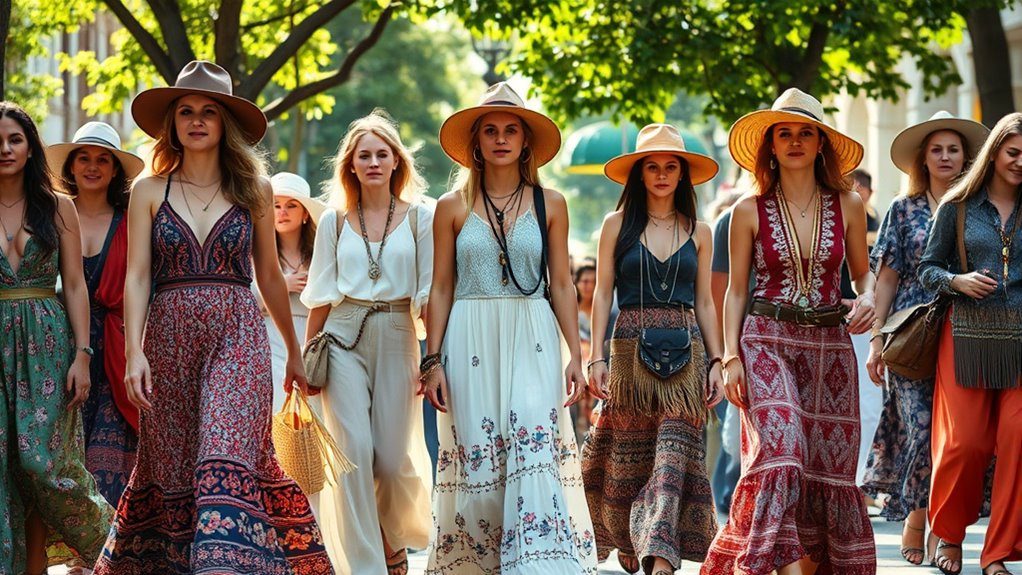
The bohemian aesthetic, once confined to underground subcultures and niche circles, gradually caught the attention of mainstream fashion over the past few decades. This shift was driven by the fashion industry’s desire for unique, expressive styles and the influence of celebrities embracing boho-chic looks. As icons and performers wore flowing skirts, layered jewelry, and ethnic-inspired patterns, their popularity helped normalize bohemian fashion. Retailers quickly picked up on this trend, incorporating boho elements into mass-market collections. Celebrities’ street style choices and red carpet appearances made bohemian styles highly visible, encouraging wider adoption. Over time, what was once a rebellious subculture became a staple of mainstream fashion, blending free-spirited aesthetics with commercial appeal. Additionally, the affiliate marketing landscape played a role in popularizing bohemian fashion by enabling niche brands to reach wider audiences online. The evolution also reflects a broader trend of cultural crossover, where styles from specific communities are integrated into global fashion trends. This growing acceptance has also been supported by advancements in textile technology, making bohemian-inspired fabrics and patterns more accessible and durable for mass production.
Modern Interpretations and the Boho-Chic Style
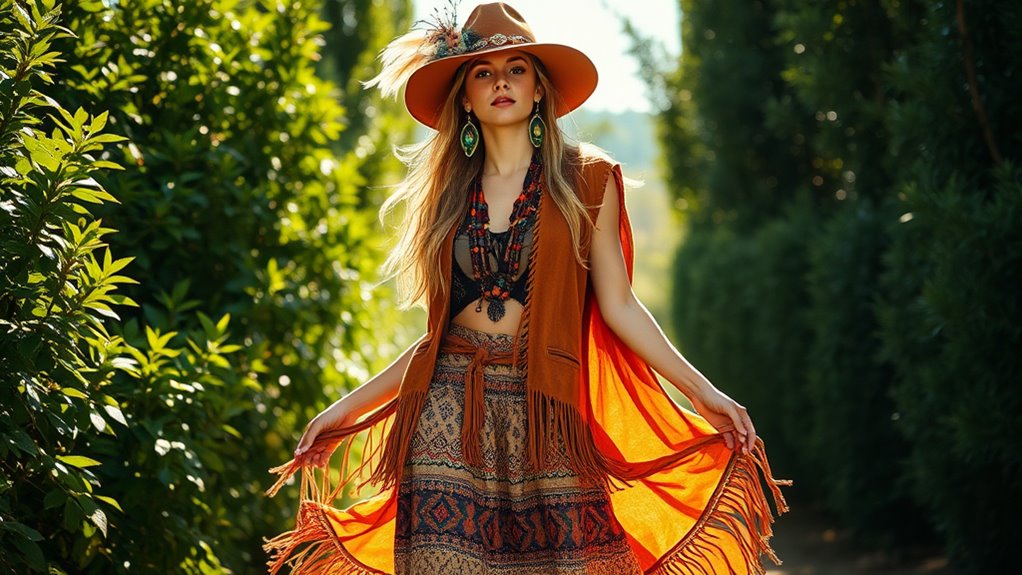
How have modern designers and consumers reinterpreted bohemian fashion to keep it fresh and relevant? They embrace sustainable fabrics, prioritizing eco-friendly materials like organic cotton, hemp, and recycled textiles, which align with current values of environmental consciousness. The boho-chic style now features streamlined silhouettes and minimalist accessories, moving away from overly layered or ornate looks. You’ll notice simpler jewelry, sleek scarves, and understated bags that complement flowing dresses and relaxed separates. This blend of sustainability and minimalism keeps bohemian fashion contemporary while honoring its free-spirited roots. By integrating eco-conscious choices with pared-down details, today’s reinterpretation appeals to a broader audience seeking stylish, ethical, and versatile wardrobe options rooted in boho’s timeless essence. Additionally, many designers incorporate craftsmanship and traditional techniques to maintain authenticity while modernizing the aesthetic. Furthermore, the rise of virtual fashion shows has allowed brands to showcase eco-friendly designs to a global audience, reinforcing sustainable principles in modern bohemian fashion. Emphasizing attention to detail and quality ensures the longevity and timeless appeal of these styles.
The Enduring Appeal of Bohemian Fashion Today
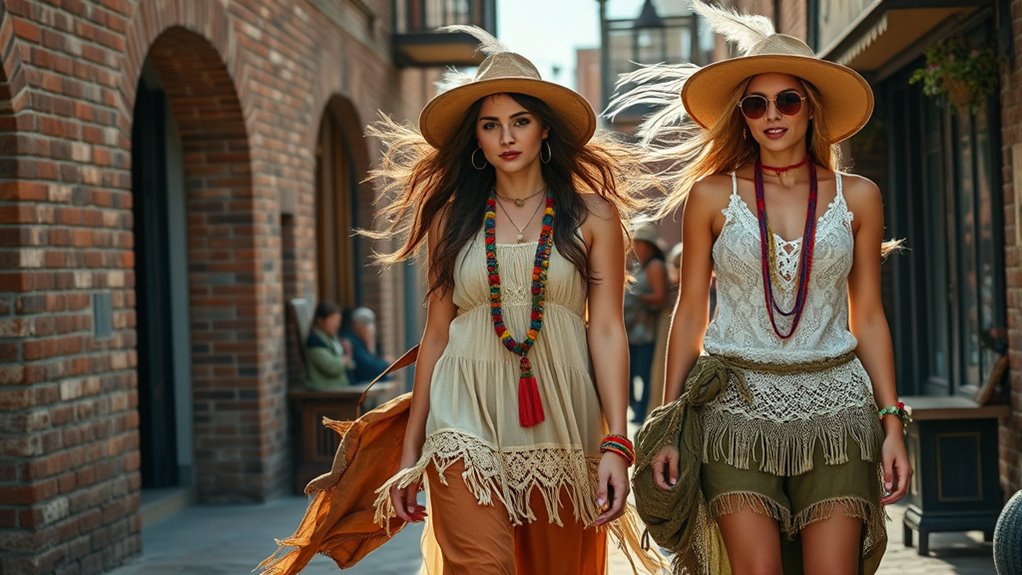
Despite changing fashion trends, bohemian style remains appealing because it embodies a sense of freedom, individuality, and effortless beauty that resonates with many people today. Its timeless charm is reinforced by current sustainable fashion trends, which emphasize eco-friendly materials and ethical practices. Celebrity influence also plays a significant role; stars often showcase boho-inspired outfits, inspiring you to embrace this relaxed yet stylish look. The trend continues to evolve, blending vintage elements with modern twists. Here’s a quick look at what keeps bohemian fashion alive: networking, which can help designers and brands collaborate to innovate within the style. Additionally, the incorporation of eco-friendly materials from self watering plant pots demonstrates how sustainability is integrated into boho aesthetics, reinforcing its connection to environmentally conscious living. The use of vintage-inspired accessories further enhances the nostalgic appeal that remains central to bohemian fashion.
Frequently Asked Questions
How Did Bohemian Fashion Influence Contemporary Runway Trends?
You see how bohemian fashion influences contemporary runway trends through the hippie revival and festival fashion. Designers draw inspiration from the relaxed, eclectic styles of the 1960s and 70s, incorporating flowy fabrics, embroidered details, and layered accessories. This blend creates a free-spirited vibe on the runway, appealing to modern audiences craving individuality and comfort, ultimately making bohemian elements a staple in current fashion collections.
What Are Some Iconic Designers Associated With Boho-Chic Style?
You might think of boho-chic style as relaxed and eclectic, but iconic designers like Free People and Anthropologie elevate it with vintage accessories and flowing fabrics. These brands bring to life free-spirited models who embody the effortless, layered look that defines bohemian fashion. Their influence is seen on runways and street style alike, blending vintage charm with modern flair, making boho-chic a timeless, versatile trend.
How Has Technology Impacted the Global Spread of Bohemian Fashion?
Technology has remarkably boosted the global spread of bohemian fashion. You can now discover boho-chic styles through social media, where influencers showcase trendy looks, inspiring your fashion choices. Online shopping makes it easy for you to buy authentic bohemian pieces from around the world, breaking down geographical barriers. This instant access allows you to incorporate bohemian elements into your wardrobe effortlessly, making the style more accessible and popular worldwide.
Are There Specific Cultural Sensitivities Related to Ethnic Patterns in Boho Fashion?
Imagine walking through a vibrant marketplace where every pattern whispers a story. When you wear ethnically inspired patterns, it’s essential to respect cultural sensitivities and avoid cultural appropriation. Some patterns carry deep significance, and using them without understanding can offend. Always seek permission, learn their meaning, and honor their origins. By doing so, you celebrate diversity thoughtfully, ensuring your boho fashion reflects appreciation rather than appropriation.
How Do Sustainable Practices Shape Modern Bohemian Fashion Choices?
Sustainable practices deeply influence your bohemian fashion choices today. You opt for eco-friendly fabrics like organic cotton and hemp, reducing environmental impact. Ethical sourcing guarantees the brands you support prioritize fair labor practices and transparency. By choosing these options, you not only express your unique style but also contribute to a more sustainable fashion industry, aligning your wardrobe with your values and helping protect the planet for future generations.
Conclusion
Today, embracing bohemian fashion means stepping into a world where history, art, and culture collide in a dazzling explosion of style. You’re not just wearing clothes—you’re channeling centuries of rebellious spirit, vibrant patterns, and wild creativity. It’s a magnetic, unstoppable force that transforms your look into a breathtaking masterpiece. So go ahead, immerse yourself in the boho-chic craze and unleash a fashion revolution that’s more epic than you ever imagined!
